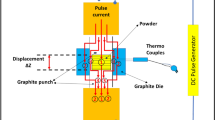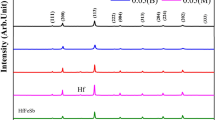Abstract
HfB2–15 vol% MoSi2 composites were produced from powder mixtures and densified through different techniques, namely hot pressing and spark plasma sintering. Dense materials were obtained at 1900 °C by hot pressing and at 1750 °C by spark plasma sintering. Microstructure and mechanical properties were compared. The most relevant result was for high-temperature strength: independent of the processing technique, the flexural strength in air at 1500 °C was higher than 500 MPa.
Similar content being viewed by others
References
M.M. Opeka, I.G. Talmy, J.A. Zaykoski: Oxidation-based materials selection for 2000 °C+ hypersonic aerosurfaces: Theoretical consideration and historical experience. J. Mater. Sci. 39, 5887 (2004).
K. Upadhya, J.M. Yang, W.P. Hoffmann: Materials for ultrahigh temperature structural applications. Am. Ceram. Soc. Bull. 58, 51 (1997).
G. Van Goor, P. de Sagesser, K. Berroth Electrically conductive ceramic composites, in Advanced Multilayered and Fibre-Reinforced Composites edited by Y.M. Haddad (Kluwer Academic, The Netherlands, 1998), pp. 311–322.
E.V. Clougherty, D. Kalishi, and E.T. Peters: Research and development of refractory oxidation resistant diborides, Technical Report AFML-TR-68-190 (1968).
M. Gasch, D. Elleby, E.I. Irby, S. Beckam, M. Gusman, S. Johnson: Processing, properties and arc jet oxidation of hafnium diboride/silicon carbide ultra high temperature ceramics. J. Mater. Sci. 39, 5925 (2004).
M.M. Opeka, I.G. Talmy, E.J. Wuchina, J.A. Zaykoski, S.J. Causey: Mechanical, thermal, and oxidation properties of refractory hafnium and zirconium compounds. J. Eur. Ceram. Soc. 19, 2405 (1999).
E. Wuchina, M. Opeka, S. Causey, K. Buesking, J. Spain, A. Cull, J. Routbort, Guitierrez-F. Mora: Designing for ultrahigh-temperature applications: The mechanical and thermal properties of HfB2, HfCx, HfNx, and Hf(N). J. Mater. Sci. 39, 5939 (2004).
V. Medri and A. Bellosi: Microstructure and properties of hot pressed hafnium diboride with silicon nitride as sintering aid (unpublished).
F. Monteverde, A. Bellosi: Efficacy of HfN as sintering aid in the manufacture of ultrahigh-temperature metal diborides-matrix ceramics. J. Mater. Res. 19, 3576 (2004).
A.L. Chamberlain, W.G. Fahrenholtz, G.E. Hilmas Characterization of zirconium diboride-molybdenum disilicide ceramics, in Advances in Ceramic Matrix Composites IX Ceram. Trans. Vol. 153, edited by N.P. Bansal, J.P. Singh, W.M. Kriven, and H. Schneider, (Am. Ceram. Soc., Westerville, OH, 2003), p. 299.
D. Sciti, M. Brach, A. Bellosi: Oxidation behavior of a pressureless sintered ZrB2–MoSi2 ceramic composite. J. Mater. Res. 20, 922 (2005).
D.G. Munz J.L. Shannon Jr. R.T. Bubsey: Fracture toughness calculation from maximum load in four point bend tests of chevron notch specimens. Int. J. Fract. 16, R137 (1980).
M. Nygren, Z. Shen: Novel assemblies via spark plasma sintering. Silic. Indus. 69, 211 (2004).
V. Mamedov: Spark plasma sintering as advanced PM sintering method. Powder Metall. 45, 322 (2002).
J.R. Groza, A. Zavaliangons: Sintering activation by electrical field. Mater. Sci. Eng. A 287, 171 (2000).
Y.L. Jeng, E.J. Lavernia: Review: Processing of molybdenum disilicide. J. Mater. Sci. 29, 2557 (1994).
E.M. Levin, C.R. Robbins, H.F. Murdie McPhase diagram for ceramists (Am. Ceram. Soc., Columbus, OH, 1969), 1969 Suppl., p. 98.
F. Monteverde, A. Bellosi: Microstructure and properties of an HfB2-SiC composite for ultra high temperature applications. Adv. Eng. Mater. 6, 331 (2004).
Y.T. Zhu, M. Stan, S.D. Conzone, D.P. Butt: Thermal oxidation kinetics of MoSi2-based powders. J. Am. Ceram. Soc. 82, 2785 (1999).
Author information
Authors and Affiliations
Corresponding author
Rights and permissions
About this article
Cite this article
Sciti, D., Silvestroni, L. & Bellosi, A. Fabrication and properties of HfB2–MoSi2 composites produced by hot pressing and spark plasma sintering. Journal of Materials Research 21, 1460–1466 (2006). https://doi.org/10.1557/jmr.2006.0180
Received:
Accepted:
Published:
Issue Date:
DOI: https://doi.org/10.1557/jmr.2006.0180




